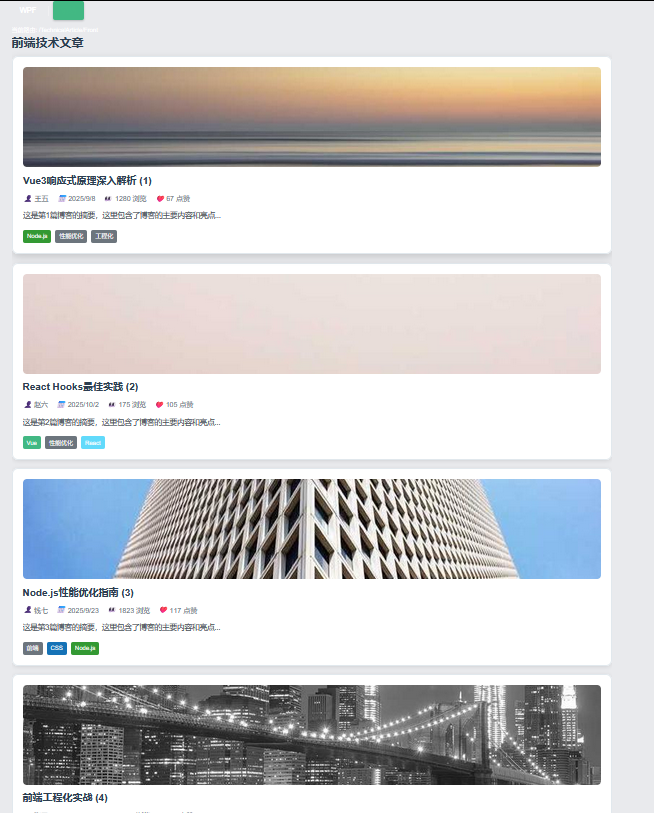尝试使用vue生成一个界面,界面上条目都是同样的模板,效果如下:

每个文章界面结构相同,js代码中提供了文章实体的链表,界面加载的时候根据这些实体自动生成对应UI;
1.编写数据提供类:blogData.js
javascript
// 博客数据模拟
export const generateBlogList = (count = 10) => {
const titles = [
'Vue3响应式原理深入解析',
'React Hooks最佳实践',
'Node.js性能优化指南',
'前端工程化实战',
'微前端架构设计',
'Webpack5新特性解析',
'TypeScript泛型应用',
'CSS-in-JS方案比较',
'前端测试策略',
'浏览器渲染原理'
]
const authors = ['张三', '李四', '王五', '赵六', '钱七']
const tagsPool = ['Vue', 'React', 'JavaScript', 'TypeScript', 'CSS', 'Node.js', '前端', '工程化', '性能优化']
return Array.from({ length: count }, (_, index) => {
const tagCount = Math.floor(Math.random() * 3) + 2
const selectedTags = []
for (let i = 0; i < tagCount; i++) {
const randomTag = tagsPool[Math.floor(Math.random() * tagsPool.length)]
if (!selectedTags.includes(randomTag)) {
selectedTags.push(randomTag)
}
}
return {
id: index + 1,
title: titles[index % titles.length] + ` (${index + 1})`,
author: authors[Math.floor(Math.random() * authors.length)],
publishDate: new Date(Date.now() - Math.random() * 30 * 24 * 60 * 60 * 1000).toISOString().split('T')[0],
summary: `这是第${index + 1}篇博客的摘要,这里包含了博客的主要内容和亮点...`,
content: `这是第${index + 1}篇博客的完整内容...`,
tags: selectedTags,
views: Math.floor(Math.random() * 2000),
likes: Math.floor(Math.random() * 150),
coverImage: `https://picsum.photos/800/400?random=${index}`
}
})
}
// 导出固定数据
export const blogList = generateBlogList(8)2.定义单个文章组件模板
BlogCard.vue
html
<template>
<article class="blog-card" @click="$emit('view-detail', blog)">
<div class="blog-header">
<img v-if="blog.coverImage" :src="blog.coverImage" :alt="blog.title" class="cover-image">
<h3 class="blog-title">{{ blog.title }}</h3>
</div>
<div class="blog-meta">
<span class="author">
<i class="icon-user"></i>{{ blog.author }}
</span>
<span class="date">
<i class="icon-calendar"></i>{{ formatDate(blog.publishDate) }}
</span>
<span class="views">
<i class="icon-eye"></i>{{ blog.views }} 浏览
</span>
<span class="likes">
<i class="icon-heart"></i>{{ blog.likes }} 点赞
</span>
</div>
<p class="blog-summary">{{ blog.summary }}</p>
<div class="blog-tags">
<span
v-for="tag in blog.tags"
:key="tag"
class="tag"
:style="{ backgroundColor: getTagColor(tag) }"
>
{{ tag }}
</span>
</div>
</article>
</template>
<script>
export default {
name: 'BlogCard',
props: {
blog: {
type: Object,
required: true
}
},
methods: {
formatDate(dateString) {
return new Date(dateString).toLocaleDateString('zh-CN')
},
getTagColor(tag) {
const colors = {
'Vue': '#42b883',
'React': '#61dafb',
'JavaScript': '#f7df1e',
'TypeScript': '#3178c6',
'CSS': '#1572b6',
'Node.js': '#339933'
}
return colors[tag] || '#6c757d'
}
}
}
</script>
<style scoped>
.blog-card {
border: 1px solid #e1e8ed;
border-radius: 12px;
padding: 20px;
margin-bottom: 16px;
background: white;
cursor: pointer;
transition: all 0.3s ease;
box-shadow: 0 2px 8px rgba(0,0,0,0.1);
}
.blog-card:hover {
transform: translateY(-2px);
box-shadow: 0 4px 16px rgba(0,0,0,0.15);
}
.cover-image {
width: 100%;
height: 200px;
object-fit: cover;
border-radius: 8px;
margin-bottom: 12px;
}
.blog-title {
color: #2c3e50;
margin: 0 0 12px 0;
font-size: 1.25rem;
line-height: 1.4;
}
.blog-meta {
display: flex;
flex-wrap: wrap;
gap: 16px;
margin-bottom: 12px;
font-size: 0.875rem;
color: #6c757d;
}
.blog-meta span {
display: flex;
align-items: center;
gap: 4px;
}
.blog-summary {
color: #495057;
line-height: 1.6;
margin-bottom: 16px;
display: -webkit-box;
-webkit-line-clamp: 3;
-webkit-box-orient: vertical;
overflow: hidden;
}
.blog-tags {
display: flex;
flex-wrap: wrap;
gap: 8px;
}
.tag {
padding: 4px 8px;
border-radius: 4px;
color: white;
font-size: 0.75rem;
font-weight: 500;
}
/* 图标样式 */
.icon-user::before { content: '👤 '; }
.icon-calendar::before { content: '📅 '; }
.icon-eye::before { content: '👀 '; }
.icon-heart::before { content: '❤️ '; }
</style>3.在父容器中使用v-for呈现
html
<template>
<div class="front-container">
<h2>前端技术文章</h2>
<div class="blog-list">
<BlogCard
v-for="blog in blogs"
:key="blog.id"
:blog="blog"
@view-detail="handleViewDetail"
/>
</div>
</div>
</template>
<script>
import { blogList } from '../../mock/blogData'
import BlogCard from '@/components/BlogCard.vue'
export default {
name: 'BlogList',
components: {
BlogCard
},
data() {
return {
blogs: blogList
}
},
methods: {
handleViewDetail(blog) {
console.log('查看博客详情:', blog)
}
}
}
</script>分析:
数据流向:
blogData.js文件提供了blogList属性,在父容器中通过blogs引用了blogList,在父容器的v-for中把blogs中每一个实体又给到了BlogCard.vue的blog属性,完成数据填充。
其中包